Professional Quality of Life among Healthcare Workers: A Case Study Conducted during the COVID-19 Pandemic
Abstract
 Abstract Views: 0
Abstract Views: 0
Coronavirus is an infectious respiratory disease. Following its outbreak in China, the virus spread rapidly throughout the world. Consequently, the WHO declared it as a serious international emergency concern. The healthcare workers (HCWs) fighting as active and critical frontline warriors during the COVID-19 pandemic were at a high risk of exhibiting psychosocial stress and mental health symptoms. The aim of this study was to evaluate the professional quality of life of healthcare workers during the COVID-19 pandemic. The population of this research consisted of 238 HCWs. The data was collected through online Google forms and participants were assessed by using professional quality of life tool (ProQOL-5). The results showed that the majority (84.2%) of HCWs had average compassion satisfaction (CS), while only 14.6% had high CS scores. For burnout, the majority had average scores whereas only 8.3% had a low count of burnout. Similarly, the majority of the participants had average secondary traumatic (ST) stress (88.3%), while 9.2% had low ST stress, and 2.5% had high ST stress. This study concluded that the healthcare workers (HCWs) had average CS, burnout, and ST stress






